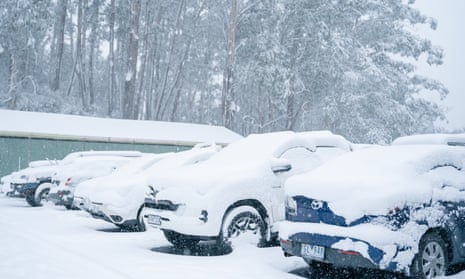Plan an Unforgettable Winter Vacation to Experience Snow In Australia with Family
Plan an Unforgettable Winter Vacation to Experience Snow In Australia with Family
Blog Article
Discover the Fascinating Effects of Snow in Australia on Neighborhood Environments
Regardless of its online reputation for sun-soaked landscapes, Australia also flaunts regions blanketed by snow-- a sensation that profoundly influences the country's one-of-a-kind ecological communities. The protecting residential or commercial properties of snowflakes shield plants and animals amidst the chilliest wintertimes, while the melting snow nurtures rivers and marine life.
The Unforeseen Areas of Snowfall in Australia
Although Australia is often connected with sandy coastlines and sun-scorched landscapes, certain areas surprisingly experience snowfall. The high country regions of New South Wales, Victoria, and Tasmania are specifically understood for their winter months snow. The Snowy Mountains in NSW, for circumstances, obtain bountiful seasonal snow, providing a plain contrast to the nation's normal hot, dry environment. On the other hand, the Victorian Alps and components of Tasmania additionally see yearly snowfalls, changing the landscape into a winter months heaven. These locations are not simply abnormalities however important parts of Australia's varied environment system. The existence of snow in these regions substantially affects local communities, ultimately influencing the nation's unique biodiversity. The specific impact on Australia's unique plants will certainly be discussed in the following section.

Exactly How Snow Impacts Australia's Special Vegetation
These plants have actually advanced to survive in extreme problems, with snow serving as a safety covering from extreme winds and freezing temperature levels. The snow also contributes to the wetness material of the soil, providing essential hydration for plant life during the completely dry summer season months. In essence, the snow influences the timing of blooming and seed dispersal, the growth rates, and the survival of many plant varieties, showcasing the complex interplay in between climate and plants in Australia.

The Adaptations of Australian Fauna to Snowfall
Equally as Australia's plants has actually adjusted to the wintery problems, the neighborhood fauna also, exhibit amazing adaptations to the snowfall. Species like the Hill Pygmy-possum, the only Australian marsupial recognized to hibernate, have progressed approaches to make it through in snowy settings. It uses the snow as insulation, hibernating in rock crevices under the snow to stay cozy. Likewise, the Snow Skink, a species of lizard, transforms its colour to white during wintertime, offering camouflage against predators. Birds such as the Snowy Hills' Crimson Rosella also readjust their diet plans to eat offered food resources during cooler periods. Thus, despite the extreme conditions, Australian animals demonstrates a resilient and adaptive nature, ensuring their survival in areas experiencing snowfall.
The Function of Snow fit Regional Environments
Fit the local communities, the function of snow in Australia is both extensive and multilayered. It affects the distribution of flora and fauna, largely defining the biodiversity of sub-alpine and alpine regions. Snow offers a vital water source, feeding rivers and reservoirs as it melts, therefore supporting a variety of marine life forms. Furthermore, snow works as an insulator, protecting ground-dwelling microorganisms from extreme cold. In a similar way, it plays a considerable function in dirt development and nutrient biking. The periodic freezing and thawing of dirt generated by snowfall cultivates the breakdown of rocks, boosting dirt fertility. The visibility of snow shapes the greenery patterns, pet habits, and general sustainability of Australia's one-of-a-kind communities.

The Future of Snowfall in Australia: Effects and predictions

Offered the essential duty snow plays fit regional environments, the future of snowfall in Australia is drawing boosting focus from environmentalists and scientists. Existing environment models anticipate a considerable like it decrease in snowfall due to global warming, with potentially extensive effect on neighborhood communities. Less snow might result in minimized water availability in towering areas, negatively impacting wildlife habitats and plant life. Moreover, it could alter the timing of seasonal changes, interfering with the life process of lots of indigenous types. The tourist industry, greatly dependent on the winter months snow period, may additionally deal with substantial challenges. Recognizing these forecasts and their ramifications Look At This is important to develop efficient preservation approaches, guaranteeing the conservation of Australia's one-of-a-kind biodiversity and the sustainability of its economic situation.
Conclusion
The function of snow in Australia's ecological communities is critical yet often neglected. It serves as a protector, a nurturer, and a shaper of varied towering species, adding to the splendor of Australia's high nation. As weather patterns continue to move, comprehending the effects and prospective transformations of these snow-influenced communities is essential. Hence, the snow in Australia is greater than a natural phenomenon; it's an essential gamer in the country's ecological story.
Regardless of its credibility for sun-soaked landscapes, Australia additionally boasts areas buried by snow-- a sensation that profoundly affects the nation's unique her comment is here ecosystems. It utilizes the snow as insulation, hibernating in rock gaps below the snow to stay cozy - Does It Snow In Australia.In shaping the neighborhood environments, the function of snow in Australia is both multilayered and extensive. The presence of snow shapes the vegetation patterns, animal habits, and general sustainability of Australia's one-of-a-kind ecosystems
Offered the important role snow plays in forming regional communities, the future of snowfall in Australia is attracting increasing attention from ecologists and researchers.
Report this page